Tsoulfanidis N. Measurement and detection of radiation
Подождите немного. Документ загружается.

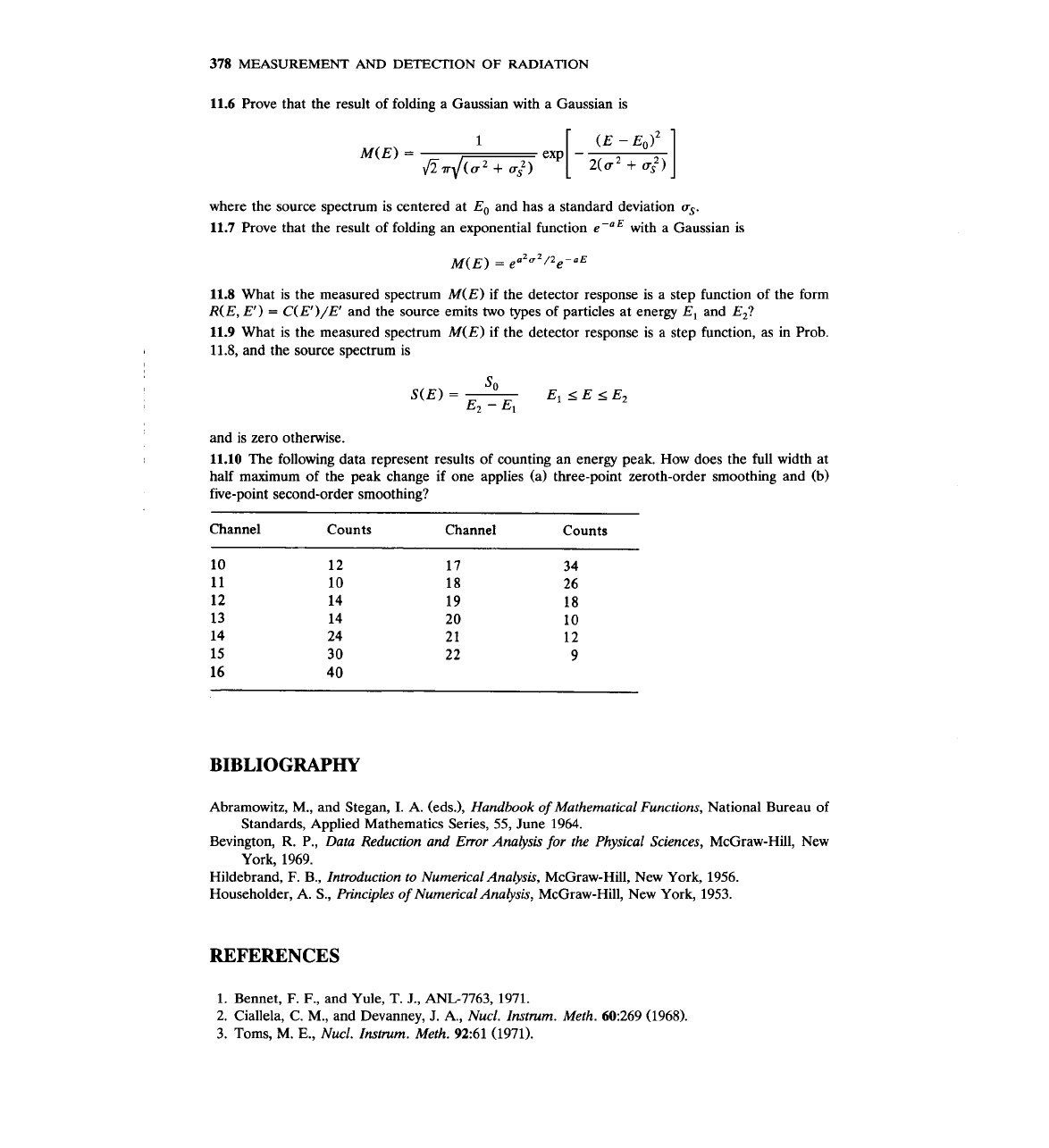
378
MEASUREMENT
AND
DETECTION OF RADIATION
11.6
Prove that the result of folding a Gaussian with a Gaussian is
where the source spectrum is centered at Eo and has a standard deviation
a,.
11.7
Prove that the result of folding an exponential function ePE with a Gaussian is
11.8
What is the measured spectrum M(E) if the detector response is a step function of the form
R(E, E')
=
C(Ef)/E' and the source emits two types of particles at energy El and
E,?
11.9
What is the measured spectrum M(E) if the detector response is a step function, as in Prob.
11.8,
and the source spectrum is
and is zero otherwise.
11.10
The following data represent results of counting an energy peak. How does the full width at
half maximum of the peak change if one applies (a) three-point zeroth-order smoothing and (b)
five-point second-order smoothing?
Channel Counts Channel Counts
BIBLIOGRAPHY
Abramowitz, M., and Stegan,
I.
A. (eds.), Handbook of Mathematical Functions, National Bureau of
Standards, Applied Mathematics Series,
55,
June
1964.
Bevington,
R.
P., Data Reduction
and
Error Analysis for the Physical Sciences, McGraw-Hill, New
York, 1969.
Hildebrand,
F.
B., Introduction to Numerical Analysis, McGraw-Hill, New York,
1956.
Householder, A. S., Principles of Numerical Analysis, McGraw-Hill, New York,
1953.
REFERENCES
1.
Bennet,
F.
F.,
and Yule,
T.
J.,
ANL-7763, 1971.
2.
Ciallela, C. M., and Devanney,
J.
A,, Nucl. Inshum. Meth.
60:269
(1968).
3.
Toms,
M.
E.,
Nucl. Inshum. Meth.
92:61
(1971).
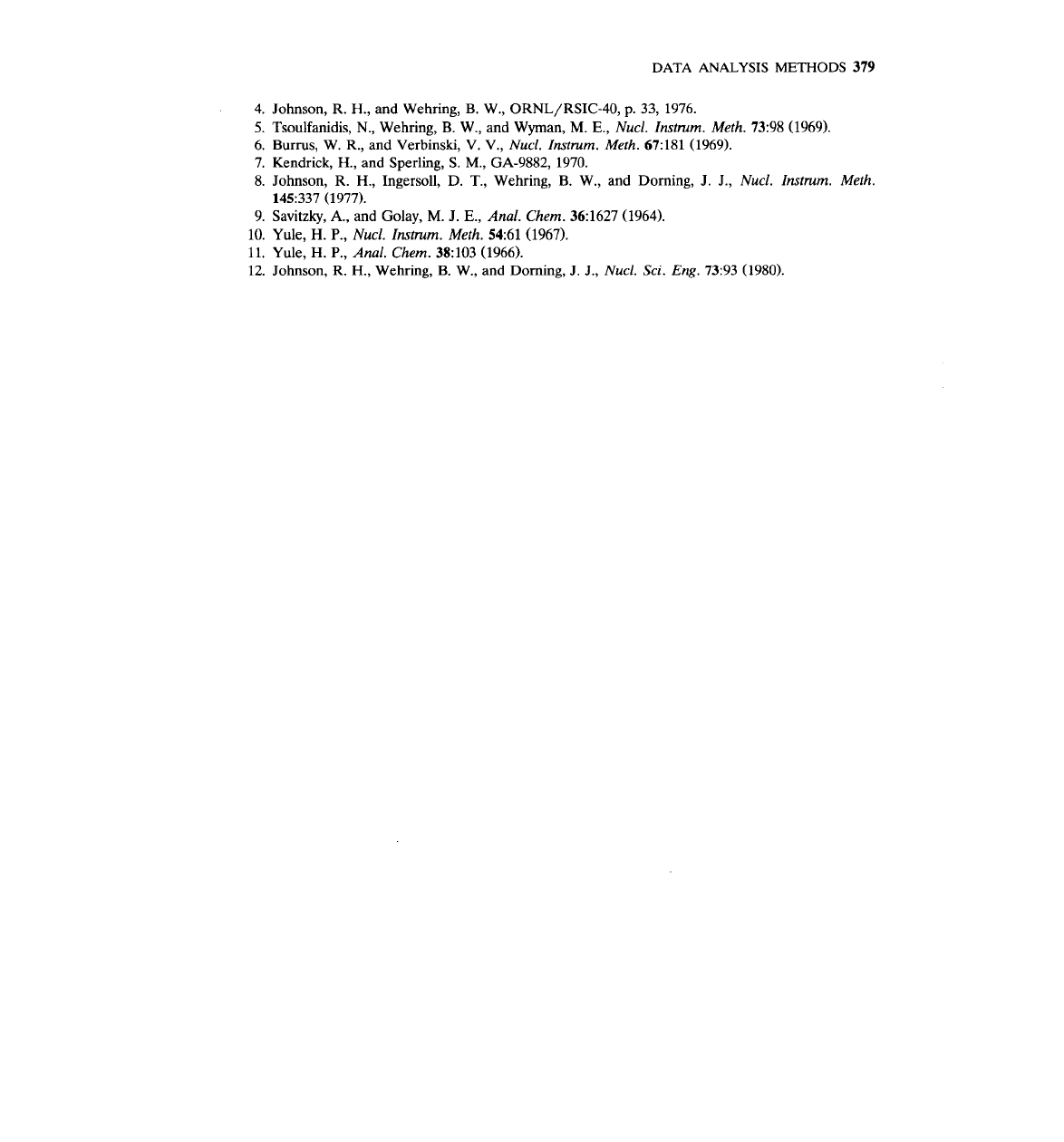
DATA ANALYSIS METHODS
379
Johnson, R. H., and Wehring,
B.
W., ORNL/RSIC-40,
p.
33, 1976.
Tsoulfanidis,
N.,
Wehring,
B.
W.,
and Wyman,
M.
E.,
Nucl. Instmm. Meth.
73:98 (1969).
Burrus, W. R., and Verbinski, V. V.,
Nucl. Instrum. Meth.
67:181 (1969).
Kendrick, H., and Sperling,
S.
M.,
GA-9882, 1970.
Johnson, R.
H.,
Ingersoll, D.
T.,
Wehring,
B.
W., and Doming,
J.
J.,
Nucl. Instrum. Meth.
145:337 (1977).
Savitzky,
A,,
and Golay,
M.
J.
E.,
Anal. Chem.
36:1627 (1964).
Yule,
H. P.,
Nucl. Instrum. Meth.
54:61 (1967).
Yule,
H. P.,
Anal. Chem.
38:103 (1966).
Johnson, R.
H.,
Wehring, B. W., and Doming, J. J.,
Nucl.
Sci.
Eng.
73:93 (1980).

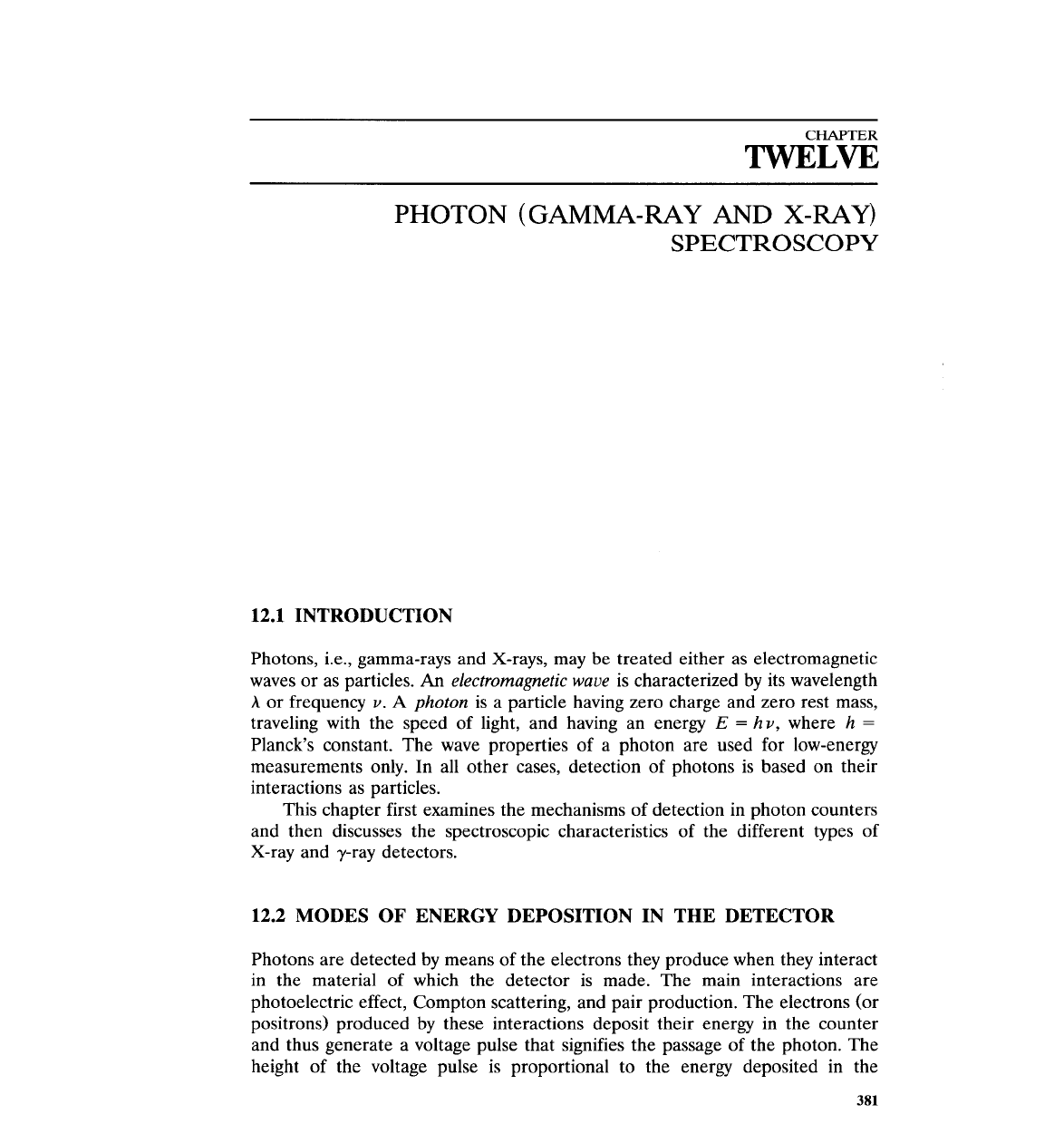
CHAPTER
TWELVE
PHOTON
(GAMMA-RAY
AND
X-RAY)
SPECTROSCOPY
12.1 INTRODUCTION
Photons, i.e., gamma-rays and X-rays, may be treated either as electromagnetic
waves or as particles.
An
electromagnetic wave
is characterized
by
its wavelength
A
or frequency
v.
A
photon
is a particle having zero charge and zero rest mass,
traveling with the speed of light, and having an energy
E
=
hv,
where
h
=
Planck's constant. The wave properties of a photon are used for low-energy
measurements only. In all other cases, detection of photons is based on their
interactions as particles.
This chapter first examines the mechanisms of detection in photon counters
and then discusses the spectroscopic characteristics of the different types of
X-ray and y-ray detectors.
12.2 MODES OF ENERGY DEPOSITION IN THE DETECTOR
Photons are detected by means of the electrons they produce when they interact
in the material of which the detector is made. The main interactions are
photoelectric effect, Compton scattering, and pair production. The electrons (or
positrons) produced by these interactions deposit their energy in the counter
and thus generate a voltage pulse that signifies the passage of the photon. The
height of the voltage pulse is proportional to the energy deposited in the
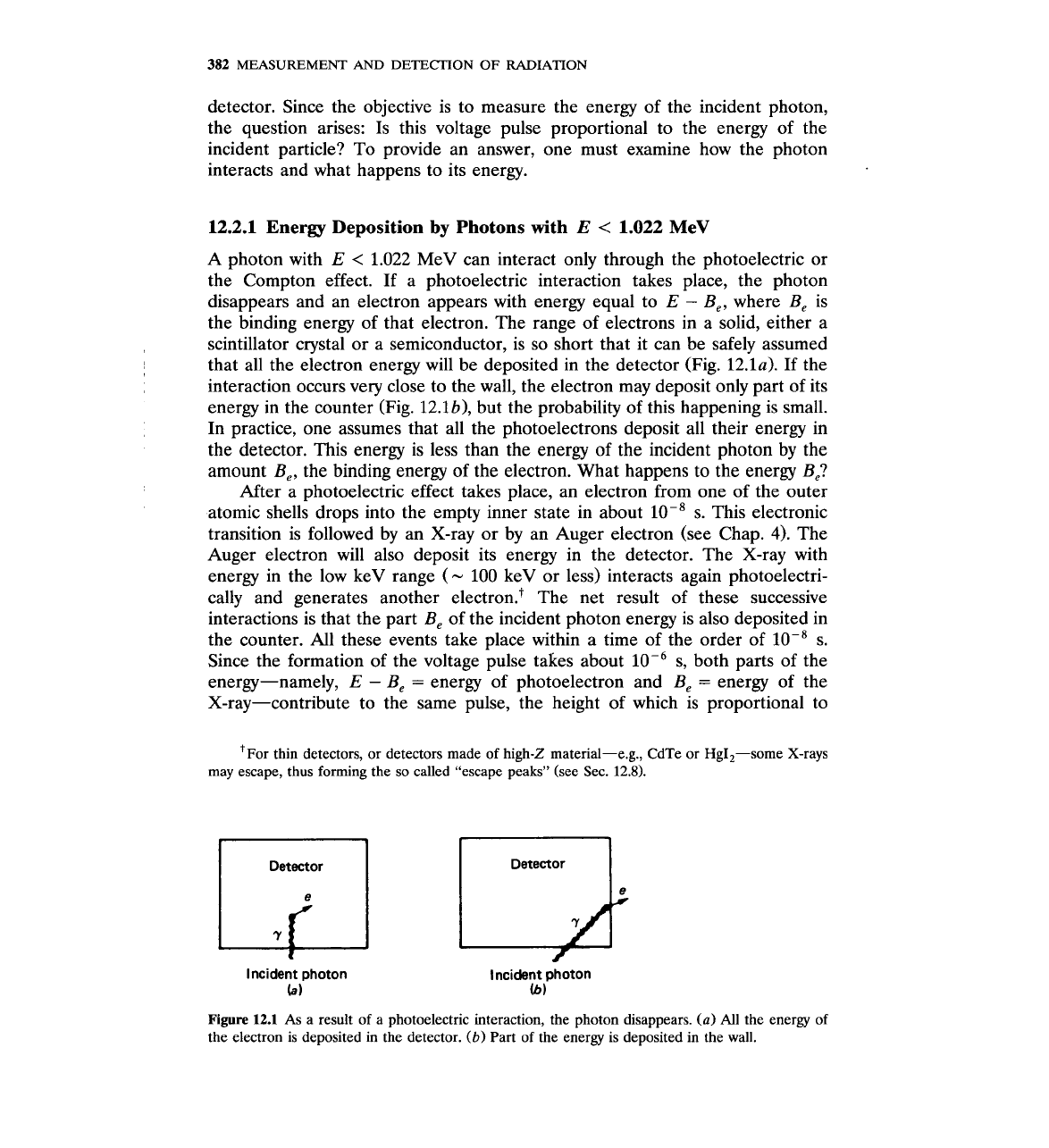
382
MEASUREMENT AND DETECTION OF RADIATION
detector. Since the objective is to measure the energy of the incident photon,
the question arises: Is this voltage pulse proportional to the energy of the
incident particle? To provide an answer, one must examine how the photon
interacts and what happens to its energy.
12.2.1 Energy Deposition
by
Photons with
E
<
1.022
MeV
A photon with
E
<
1.022 MeV can interact only through the photoelectric or
the Compton effect. If a photoelectric interaction takes place, the photon
disappears and an electron appears with energy equal to
E
-
Be, where Be is
the binding energy of that electron. The range of electrons in a solid, either a
scintillator crystal or a semiconductor, is so short that it can be safely assumed
that all the electron energy will be deposited in the detector (Fig.
12.1~). If the
interaction occurs very close to the wall, the electron may deposit only part of its
energy in the counter (Fig. 12.161, but the probability of this happening is small.
In practice, one assumes that all the photoelectrons deposit all their energy in
the detector. This energy is less than the energy of the incident photon by the
amount Be, the binding energy of the electron. What happens to the energy Be?
After a photoelectric effect takes place, an electron from one of the outer
atomic shells drops into the empty inner state in about
lo-'
s. This electronic
transition is followed by an X-ray or by an Auger electron (see Chap.
4).
The
Auger electron will also deposit its energy in the detector. The X-ray with
energy in the low
keV range
(-
100 keV or less) interacts again photoelectri-
cally and generates another electron.+ The net result of these successive
interactions is that the part Be of the incident photon energy is also deposited in
the counter. All these events take place within a time of the order of
lo-'
s.
Since the formation of the voltage pulse takes about s, both parts of the
energy-namely,
E
-
Be
=
energy of photoelectron and Be
=
energy of the
X-ray-contribute to the same pulse, the height of which is proportional to
o or
thin detectors, or detectors made of high-Z material-e.g., CdTe or Hg1,-some X-rays
may escape, thus forming the so called "escape peaks" (see Sec.
12.8).
lncident photon
(a
1
Incident photon
(b
1
Figure
12.1
As a result of a photoelectric interaction, the photon disappears. (a) All the energy of
the electron is deposited in the detector.
(b)
Part of the energy is deposited in the wall.
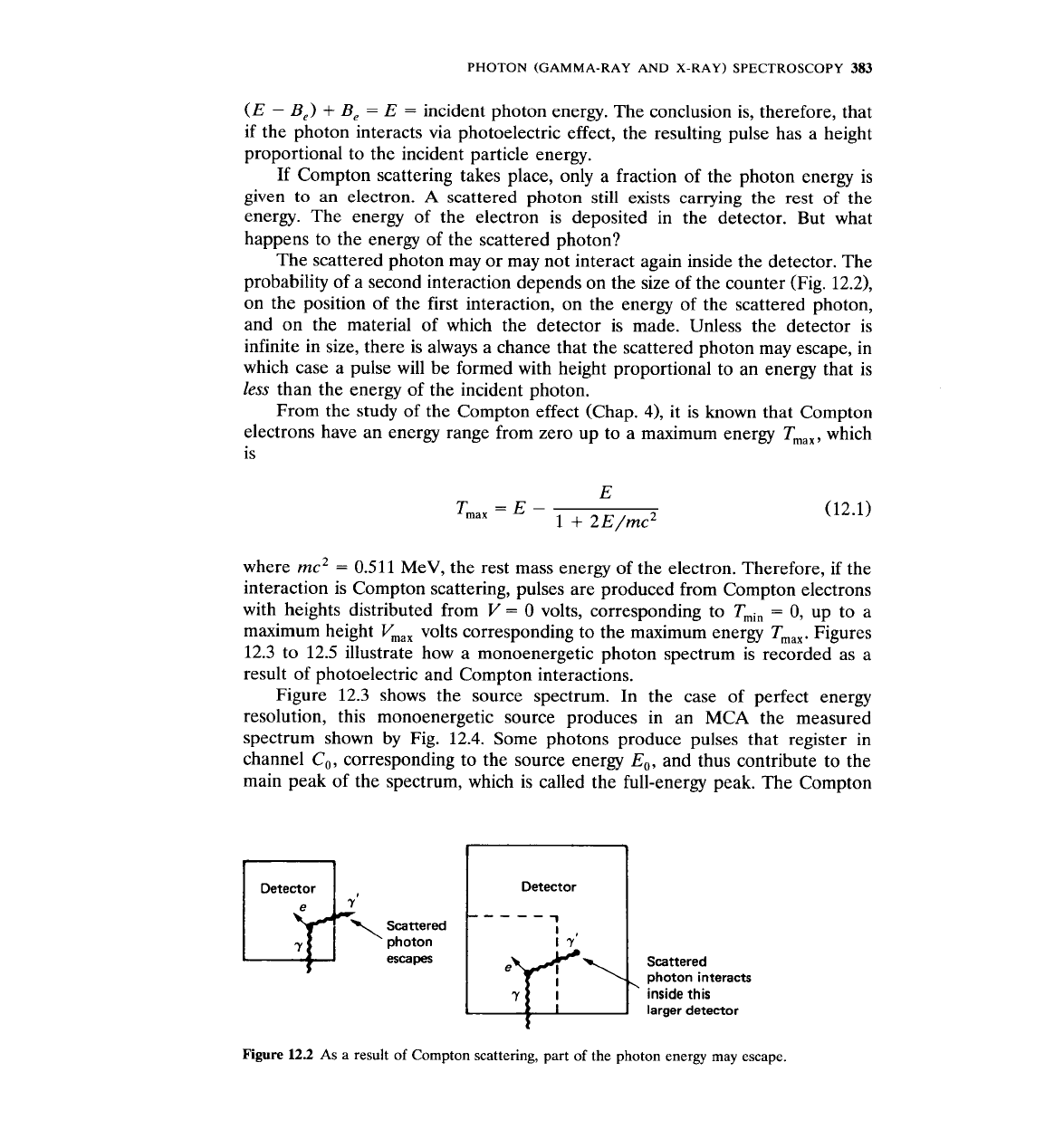
PHOTON
(GAMMA-RAY
AND
X-RAY)
SPECTROSCOPY
383
(E
-
B,)
+
B,
=
E
=
incident photon energy. The conclusion is, therefore, that
if the photon interacts via photoelectric effect, the resulting pulse has a height
proportional to the incident particle energy.
If Compton scattering takes place, only a fraction of the photon energy is
given to an electron.
A
scattered photon still exists carrying the rest of the
energy. The energy of the electron is deposited in the detector. But what
happens to the energy of the scattered photon?
The scattered photon may or may not interact again inside the detector. The
probability of a second interaction depends on the size of the counter (Fig.
12.2),
on the position of the first interaction, on the energy of the scattered photon,
and on the material of which the detector is made. Unless the detector is
infinite in size, there is always a chance that the scattered photon may escape, in
which case a pulse will be formed with height proportional to an energy that is
less
than the energy of the incident photon.
From the study of the Compton effect (Chap. 4), it is known that Compton
electrons have an energy range from zero up to a maximum energy T,,,, which
is
where
mc2
=
0.511 MeV, the rest mass energy of the electron. Therefore, if the
interaction is Compton scattering, pulses are produced from Compton electrons
with heights distributed from
V
=
0 volts, corresponding to T,,,
=
0, up to a
maximum height
V,,,
volts corresponding to the maximum energy T,,,
.
Figures
12.3 to 12.5 illustrate how a monoenergetic photon spectrum is recorded as a
result of photoelectric and Compton interactions.
Figure 12.3 shows the source spectrum. In the case of perfect energy
resolution, this monoenergetic source produces in an MCA the measured
spectrum shown
by
Fig. 12.4. Some photons produce pulses that register in
channel
C,,
corresponding to the source energy E,, and thus contribute to the
main peak of the spectrum, which is called the full-energy peak. The Compton
Detector
escapes
Scattered
\
photon interacts
inside this
larger detector
Figure
12.2
As a result of Compton scattering, part of the photon energy may escape.
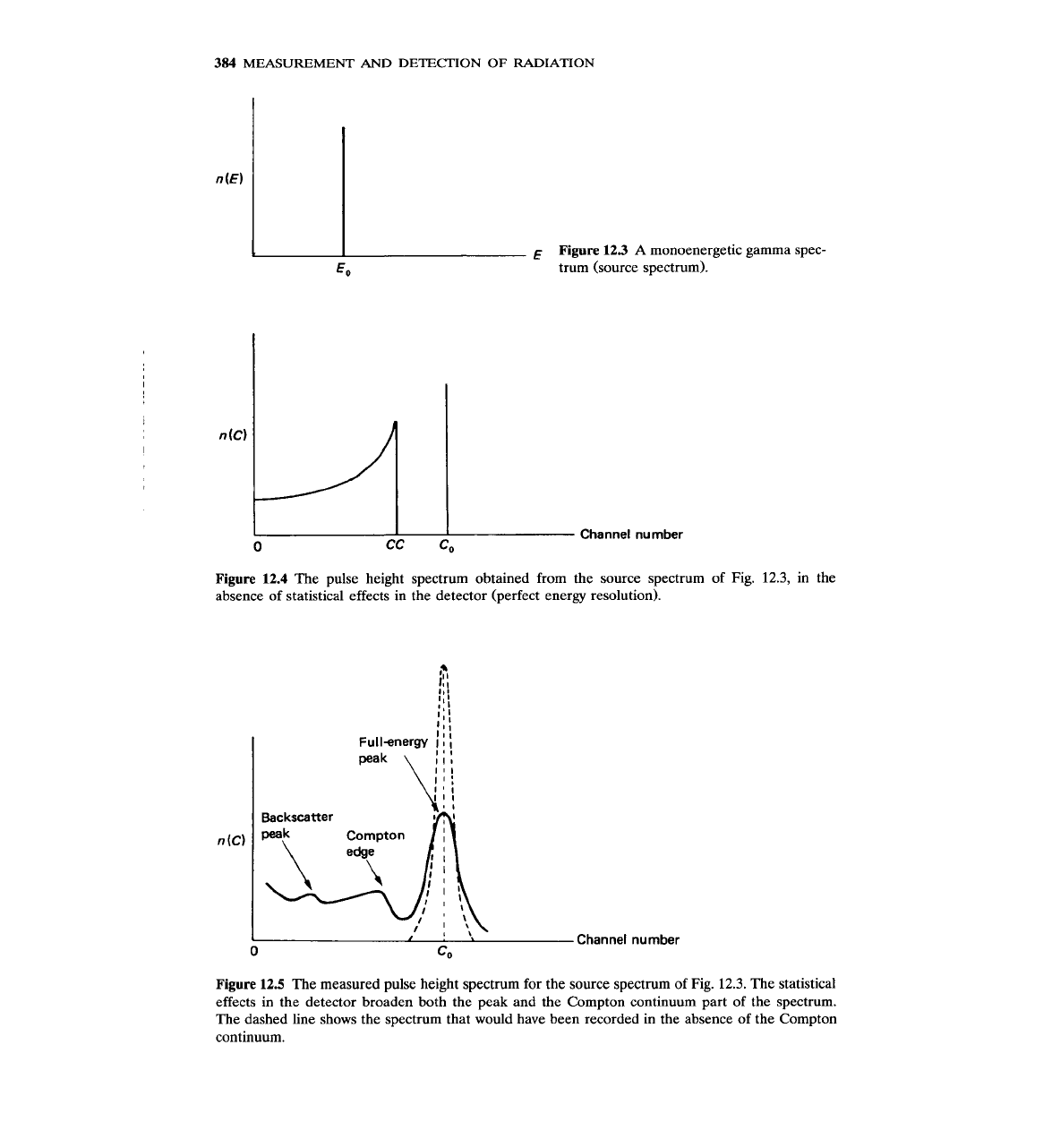
384
MEASUREMENT
AND
DETECTION
OF
RADIATION
E
Figure
123
A
monoenergetic gamma spec-
€0
trum (source spectrum).
Figure
12.4
The pulse height spectrum obtained from the source spectrum of Fig.
12.3,
in the
absence of statistical effects in the detector (perfect energy resolution).
number
Figure
12.5
The measured pulse height spectrum for the source spectrum of Fig.
12.3.
The statistical
effects in the detector broaden both the peak and the Compton continuum part of the spectrum.
The dashed line shows the spectrum that would have been recorded in the absence of the Compton
continuum.
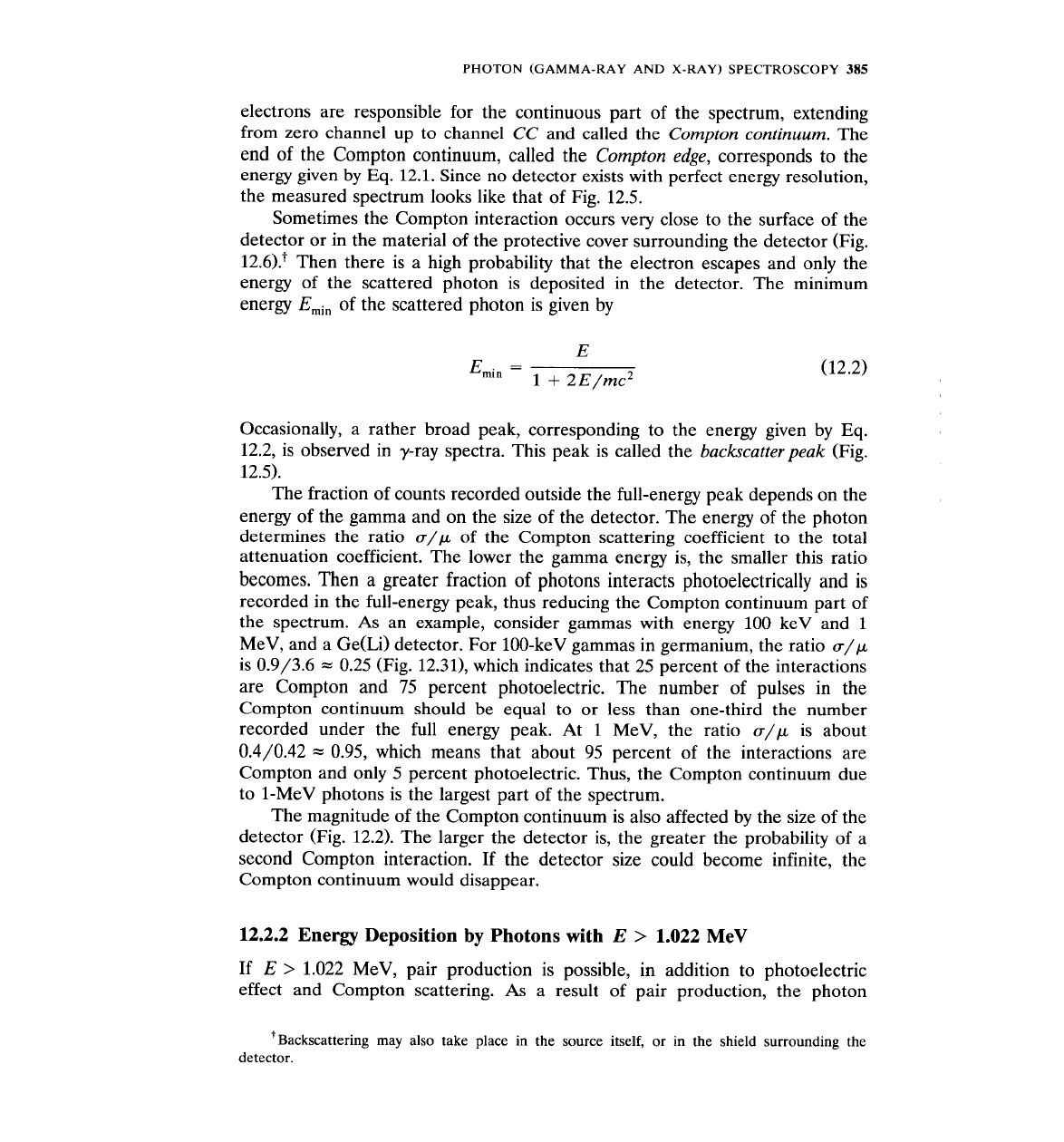
PHOTON
(GAMMA-RAY
AND
X-RAY)
SPECTROSCOPY
385
electrons are responsible for the continuous part of the spectrum, extending
from zero channel up to channel
CC
and called the
Compton continuum.
The
end of the Compton continuum, called the
Compton
edge,
corresponds to the
energy given by
Eq.
12.1.
Since no detector exists with perfect energy resolution,
the measured spectrum looks like that of Fig. 12.5.
Sometimes the Compton interaction occurs very close to the surface of the
detector or in the material of the protective cover surrounding the detector (Fig.
12.61t Then there is a high probability that the electron escapes and only the
energy of the scattered photon is deposited in the detector. The minimum
energy
Emin
of the scattered photon is given by
Occasionally, a rather broad peak, corresponding to the energy given by
Eq.
12.2, is observed in y-ray spectra. This peak is called the
backscatterpeak
(Fig.
12.5).
The fraction of counts recorded outside the full-energy peak depends on the
energy of the gamma and on the size of the detector. The energy of the photon
determines the ratio
u/p
of the Compton scattering coefficient to the total
attenuation coefficient. The lower the gamma energy is, the smaller this ratio
becomes. Then a greater fraction of photons interacts photoelectrically and
is
recorded in the full-energy peak, thus reducing the Compton continuum part of
the spectrum. As an example, consider gammas with energy 100 keV and
1
MeV, and a Ge(Li) detector. For 100-keV gammas in germanium, the ratio
CT/~
is 0.9/3.6
.=
0.25 (Fig. 12.311, which indicates that 25 percent of the interactions
are Compton and 75 percent photoelectric. The number of pulses in the
Compton continuum should be equal to or less than one-third the number
recorded under the full energy peak. At 1 MeV, the ratio
CT/~
is about
0.4/0.42
=
0.95, which means that about 95 percent of the interactions are
Compton and only
5
percent photoelectric. Thus, the Compton continuum due
to 1-MeV photons is the largest part of the spectrum.
The magnitude of the Compton continuum is also affected by the size of the
detector (Fig. 12.2). The larger the detector is, the greater the probability of a
second Compton interaction. If the detector size could become infinite, the
Compton continuum would disappear.
12.2.2 Energy Deposition
by
Photons with
E
>
1.022 MeV
If
E
>
1.022 MeV, pair production is possible, in addition to photoelectric
effect and Compton scattering. As a result of pair production, the photon
'~ackscatterin~
may
also take place in the source itself, or in the shield surrounding the
detector.

386
MEASUREMENT
AND
DETECTION
OF
RADIATION
Protective
cwer
7'
Figure
12.6
If Compton scattering occurs close to
the surface of the detector, the only energy de-
posited may be that of the scattered photon.
disappears and an electron-positron pair appears, at the expense of 1.022 MeV
transformed into the pair's rest masses. The total kinetic energy of the electron-
positron pair is
I
The kinetic energy of the pair is deposited in the counter (the arguments are the
I
same as for photoelectrons or Compton electrons). Therefore, pulses propor-
tional to the energy
T
=
E
-
1.022 MeV are certainly produced, but what
happens to the energy of 1.022 MeV?
The positron slows down and reaches the end of its range in a very short
time, shorter than the time needed for pulse formation. Sometimes while in
flight, but most of the time at the end of its track, it combines with an atomic
electron, the two annihilate, and two gammas are emitted, each with energy
0511
M~v.+
There are several possibilities for the fate of these annihilation
gammas.
1.
The energy of both annihilation gammas is deposited in the detector. Then, a
pulse height proportional to energy
(E
-
1.022) MeV
+
1.022 MeV
=
E
is produced.
2. Both annihilation photons escape.
A
pulse height proportional to energy
(E
-
1.022) MeV -is formed.
3.
One annihilation photon escapes.
A
pulse height proportional to energy
(E
-
1.022) MeV
+
0.511 MeV
=
(E
-
0.511) MeV
is formed.
If
the pair production event takes place on or close to the surface of the
detector, it is possible that only one of the annihilation photons enters the
counter. In such a case, a pulse height proportional to energy 0.511 MeV is
formed.
here
is
a
small probability that three gamma may be emitted. This event has a negligible
effect on spectroscopy measurements.
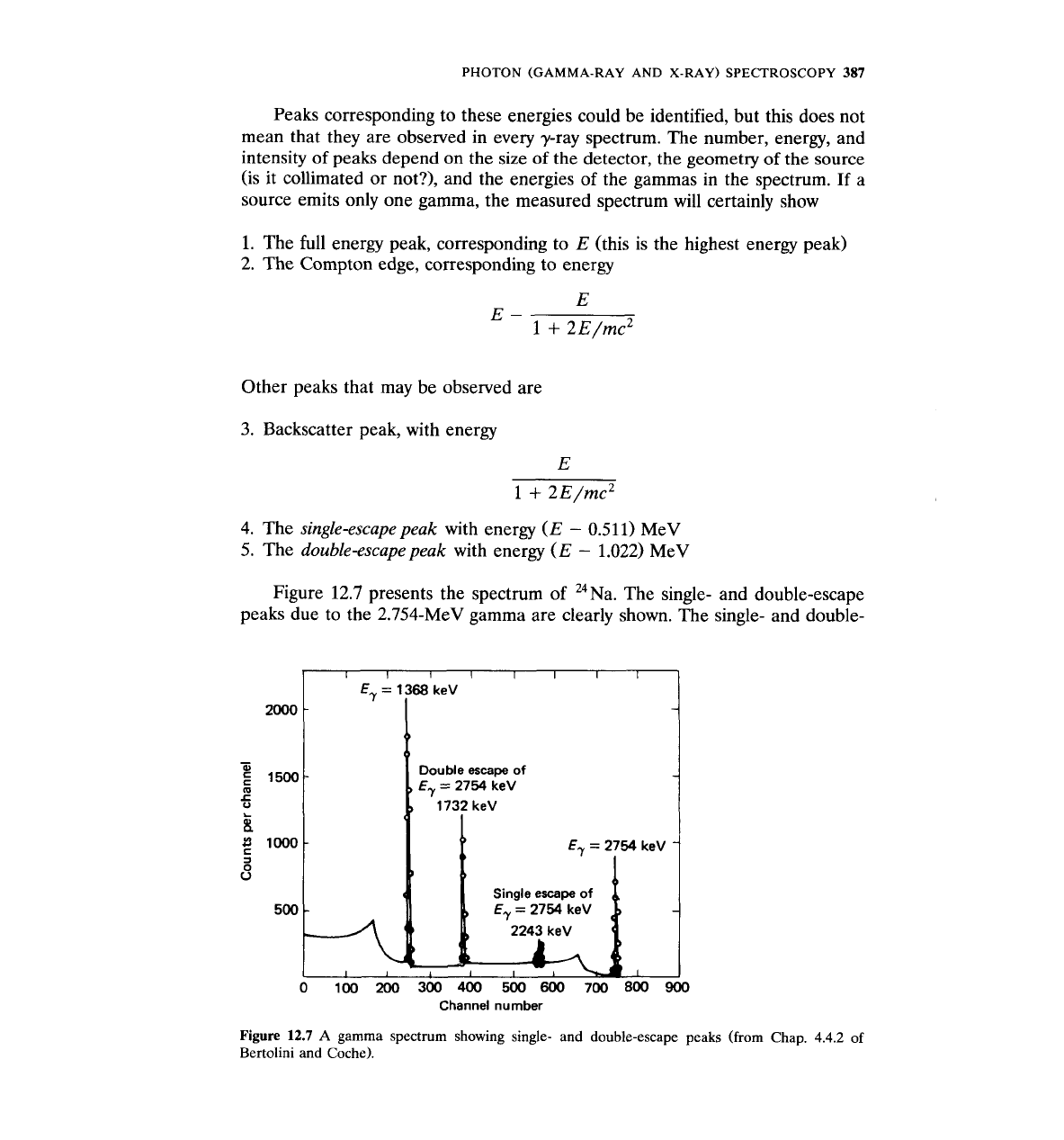
PHOTON
(GAMMA-RAY
AND
X-RAY)
SPECTROSCOPY
387
Peaks corresponding to these energies could be identified, but this does not
mean that they are observed in every y-ray spectrum. The number, energy, and
intensity of peaks depend on the size of the detector, the geometry of the source
(is it collimated or not?), and the energies of the gammas in the spectrum. If a
source emits only one gamma, the measured spectrum will certainly show
1.
The full energy peak, corresponding to
E
(this is the highest energy peak)
2. The Compton edge, corresponding to energy
Other peaks that may be observed are
3.
Backscatter peak, with energy
4. The
single-escape peak
with energy
(E
-
0.511) MeV
5.
The
double-escapepeak
with energy
(E
-
1.022) MeV
Figure 12.7 presents the spectrum of 24~a. The single- and double-escape
peaks due to the 2.754-MeV gamma are clearly shown. The single- and double-
Double
escape
of
E,,
=
2754 keV
Channel number
Figure
12.7
A
gamma spectrum showing single- and double-escape peaks (from Chap.
4.4.2
of
Bertolini and Coche).
